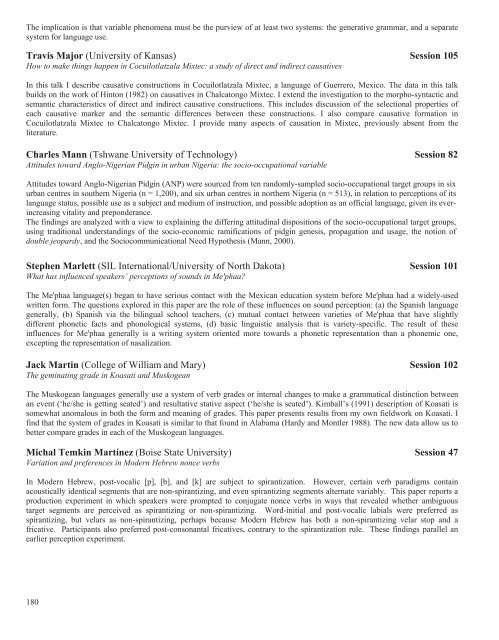here - Linguistic Society of America
here - Linguistic Society of America
here - Linguistic Society of America
You also want an ePaper? Increase the reach of your titles
YUMPU automatically turns print PDFs into web optimized ePapers that Google loves.
The implication is that variable phenomena must be the purview <strong>of</strong> at least two systems: the generative grammar, and a separatesystem for language use.Travis Major (University <strong>of</strong> Kansas) Session 105How to make things happen in Cocuilotlatzala Mixtec: a study <strong>of</strong> direct and indirect causativesIn this talk I describe causative constructions in Cocuilotlatzala Mixtec, a language <strong>of</strong> Guerrero, Mexico. The data in this talkbuilds on the work <strong>of</strong> Hinton (1982) on causatives in Chalcatongo Mixtec. I extend the investigation to the morpho-syntactic andsemantic characteristics <strong>of</strong> direct and indirect causative constructions. This includes discussion <strong>of</strong> the selectional properties <strong>of</strong>each causative marker and the semantic differences between these constructions. I also compare causative formation inCocuilotlatzala Mixtec to Chalcatongo Mixtec. I provide many aspects <strong>of</strong> causation in Mixtec, previously absent from theliterature.Charles Mann (Tshwane University <strong>of</strong> Technology) Session 82Attitudes toward Anglo-Nigerian Pidgin in urban Nigeria: the socio-occupational variableAttitudes toward Anglo-Nigerian Pidgin (ANP) were sourced from ten randomly-sampled socio-occupational target groups in sixurban centres in southern Nigeria (n = 1,200), and six urban centres in northern Nigeria (n = 513), in relation to perceptions <strong>of</strong> itslanguage status, possible use as a subject and medium <strong>of</strong> instruction, and possible adoption as an <strong>of</strong>ficial language, given its everincreasingvitality and preponderance.The findings are analyzed with a view to explaining the differing attitudinal dispositions <strong>of</strong> the socio-occupational target groups,using traditional understandings <strong>of</strong> the socio-economic ramifications <strong>of</strong> pidgin genesis, propagation and usage, the notion <strong>of</strong>double jeopardy, and the Sociocommunicational Need Hypothesis (Mann, 2000).Stephen Marlett (SIL International/University <strong>of</strong> North Dakota) Session 101What has influenced speakers’ perceptions <strong>of</strong> sounds in Me'phaa?The Me'phaa language(s) began to have serious contact with the Mexican education system before Me'phaa had a widely-usedwritten form. The questions explored in this paper are the role <strong>of</strong> these influences on sound perception: (a) the Spanish languagegenerally, (b) Spanish via the bilingual school teachers, (c) mutual contact between varieties <strong>of</strong> Me'phaa that have slightlydifferent phonetic facts and phonological systems, (d) basic linguistic analysis that is variety-specific. The result <strong>of</strong> theseinfluences for Me'phaa generally is a writing system oriented more towards a phonetic representation than a phonemic one,excepting the representation <strong>of</strong> nasalization.Jack Martin (College <strong>of</strong> William and Mary) Session 102The geminating grade in Koasati and MuskogeanThe Muskogean languages generally use a system <strong>of</strong> verb grades or internal changes to make a grammatical distinction betweenan event (‘he/she is getting seated’) and resultative stative aspect (‘he/she is seated’). Kimball’s (1991) description <strong>of</strong> Koasati issomewhat anomalous in both the form and meaning <strong>of</strong> grades. This paper presents results from my own fieldwork on Koasati. Ifind that the system <strong>of</strong> grades in Koasati is similar to that found in Alabama (Hardy and Montler 1988). The new data allow us tobetter compare grades in each <strong>of</strong> the Muskogean languages.Michal Temkin Martínez (Boise State University) Session 47Variation and preferences in Modern Hebrew nonce verbsIn Modern Hebrew, post-vocalic [p], [b], and [k] are subject to spirantization. However, certain verb paradigms containacoustically identical segments that are non-spirantizing, and even spirantizing segments alternate variably. This paper reports aproduction experiment in which speakers were prompted to conjugate nonce verbs in ways that revealed whether ambiguoustarget segments are perceived as spirantizing or non-spirantizing. Word-initial and post-vocalic labials were preferred asspirantizing, but velars as non-spirantizing, perhaps because Modern Hebrew has both a non-spirantizing velar stop and africative. Participants also preferred post-consonantal fricatives, contrary to the spirantization rule. These findings parallel anearlier perception experiment.180
















